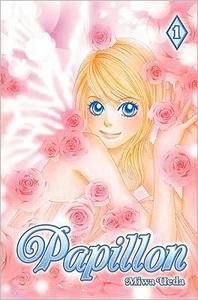Review
by Casey Brienza,Papillon
GN 1
| Synopsis: |  |
||
Hana and Ageha are identical twins, but they couldn't be more unalike. Whereas Hana is a veritable teenage beauty with a bright, gregarious personality, Ageha is a self-conscious wallflower with bad skin who is pining away in secret for her childhood crush Ryûsei. During their school's festival, Ageha meets a bizarre young man wearing a horse mask named Kyû, who urges her to chase her dreams and make Ryûsei her boyfriend. She takes the first step, and things seem to be going smashingly, but then her sister Hana decides that she wants the boy for herself. Now Ageha is in competition with her illustrious sister. Will she fall into permanent despair, or will she emerge from her chrysalis and transform herself into a beautiful butterfly? |
|||
| Review: | |||
Hmm. A shoujo manga series about an insecure but otherwise ordinary girl whose love life is being sabotaged by a super-popular pretty girl? And her only recourse for assistance against this inexplicably cruel creature is an off-beat, black-haired boy? Must be Peach Girl, right? Wrong. More's the pity. It's actually Peach Girl creator Miwa Ueda's newest title Papillon, and—ignore the nominal synopsis above—this manga is all about playing it safe. At least for now. Those eager to see Ueda do something new and different will be hard-pressed to find anything redeeming…unless they count pink, stylized butterfly wings on the cover art or perhaps a blonde heroine with lighter skin. Instead, she seems to be phoning it in. Sure enough, the four character types that made Peach Girl so unforgettable are all present and accounted for. We have the unstylish, shy, but sincere protagonist, the stylish but sadistic antagonist, the sincere but dunder-headed love interest, and the off-beat but unflappably cheerful male ally cum second love interest. Thus does Momo become Ageha, Sae become Hana, Toji become Ryûsei, and Kiley become Kyû. Unfortunately, Hana, at least for now, fails to live up to the unapologetic, utter awfulness that was Sae. In fact, it is not even clear at this point in the manga whether or not Hana is actually ruining her twin's life on purpose, or if she really is simply a strong-willed young woman who puts her own interests first, period. Should Hana turn out to be more along the lines of the latter, it will be a dreadful foreclosure of narrative possibility. The only other “villainous” personage to drive the story forward into an indefinite number of volumes would be Ageha's ugly, overweight friend, and seeing Ueda take the easy way out and conflate fat with evil would be a tragedy in itself. So although the story does not accomplish all that much in the realm of originality, it can be said, at least, that Ueda is a veteran mangaka who knows how to best exploit her creative strengths. Namely, she has an intuitive understanding of the anxieties that accompany interpersonal relationships and the best (or worst?) situations to bring those anxieties out into the open. Watching Ageha's flickering hope of romance with Ryûsei get abruptly snuffed out when her sister steals him right out from under her nose is deliciously tortuous. Just imagine your sibling showing up out of the blue while you are out on a date—and then stealing your date away! A punch to the gut, right? Anyone with a weakness for teenage angst may find the first half of this volume nearly impossible to even read. Unfortunately, such moments of masochistic entertainment do not compensate for the fact that Papillon is just an under-ripened version of Peach Girl. The only real “improvement” to be found here is Ueda's newfound over-reliance on self-help gurus to help flesh out Kyû's character and philosophy of self-empowerment. You cannot help but wonder if one too many letters to the mangaka overflowing with adolescent agonies drove her to seek counseling herself. Suffice to say, however, that there are no profundities in striking distance…just middlebrow claptrap that belongs on an afternoon talk show like Oprah. Ueda shows no improvement in the art department, either. Visually, Papillon might as well be Peach Girl yet again. Although her lines look every so slightly more precise than they did a decade ago, the difference is so subtle that it can be chalked up to the reader's over-anal imagination. The style remains reliably shoujo and mainstream, and the characters remain distinctively feral in their facial features. Panel layouts, though, are modest yet skillful and especially easy to follow. The first volume reads much faster than most manga because Ueda is good at drawing art that is not supposed to be focused upon but rather to be read through. Overall, this is not a bad shoujo manga per se, and one could do far worse. But it is, as we have seen, impossible not to compare it unfavorably to Peach Girl, and those unfamiliar with that early example of shoujo manga in the United States would be well-advised to start there instead. Then, if those eighteen volumes do not completely satisfy, and only then, should they consider taking that next logical step—a step that is, unfortunately, down—to Papillon. |
|
The views and opinions expressed in this article are solely those of the author(s) and do not necessarily represent the views of Anime News Network, its employees, owners, or sponsors.
|
| Grade: | |||
Overall : B-
Story : B-
Art : B
+ A skillfully told mainstreams shoujo tale by a veteran mangaka who has mastered masochistic entertainment. |
|||
| discuss this in the forum (3 posts) | | |||
| Production Info: | ||
|
Full encyclopedia details about Release information about |
||